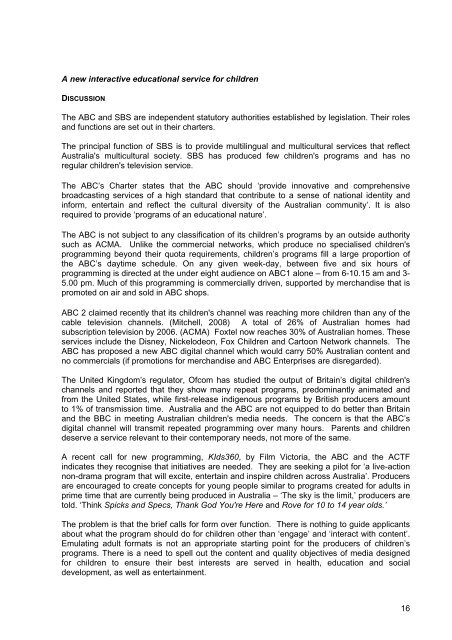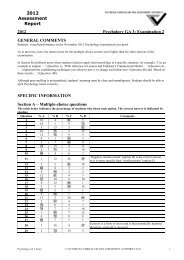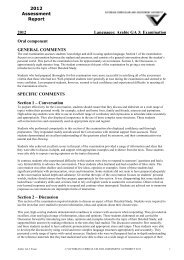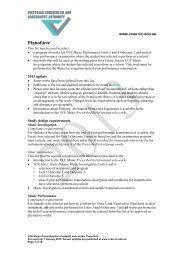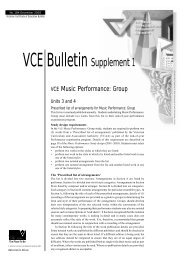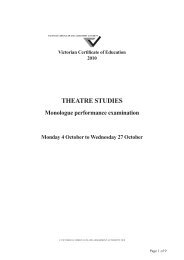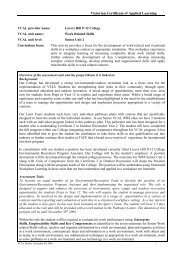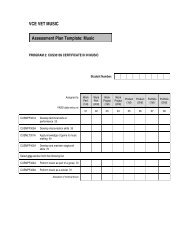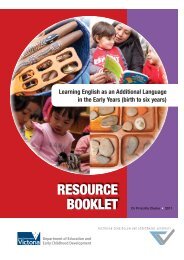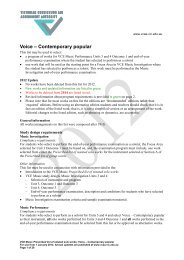television, digital media and children's learning - Victorian ...
television, digital media and children's learning - Victorian ...
television, digital media and children's learning - Victorian ...
Create successful ePaper yourself
Turn your PDF publications into a flip-book with our unique Google optimized e-Paper software.
A new interactive educational service for children<br />
DISCUSSION<br />
The ABC <strong>and</strong> SBS are independent statutory authorities established by legislation. Their roles<br />
<strong>and</strong> functions are set out in their charters.<br />
The principal function of SBS is to provide multilingual <strong>and</strong> multicultural services that reflect<br />
Australia's multicultural society. SBS has produced few <strong>children's</strong> programs <strong>and</strong> has no<br />
regular <strong>children's</strong> <strong>television</strong> service.<br />
The ABC’s Charter states that the ABC should ‘provide innovative <strong>and</strong> comprehensive<br />
broadcasting services of a high st<strong>and</strong>ard that contribute to a sense of national identity <strong>and</strong><br />
inform, entertain <strong>and</strong> reflect the cultural diversity of the Australian community’. It is also<br />
required to provide ‘programs of an educational nature’.<br />
The ABC is not subject to any classification of its children’s programs by an outside authority<br />
such as ACMA. Unlike the commercial networks, which produce no specialised <strong>children's</strong><br />
programming beyond their quota requirements, children’s programs fill a large proportion of<br />
the ABC’s daytime schedule. On any given week-day, between five <strong>and</strong> six hours of<br />
programming is directed at the under eight audience on ABC1 alone – from 6-10.15 am <strong>and</strong> 3-<br />
5.00 pm. Much of this programming is commercially driven, supported by merch<strong>and</strong>ise that is<br />
promoted on air <strong>and</strong> sold in ABC shops.<br />
ABC 2 claimed recently that its <strong>children's</strong> channel was reaching more children than any of the<br />
cable <strong>television</strong> channels. (Mitchell, 2008) A total of 26% of Australian homes had<br />
subscription <strong>television</strong> by 2006. (ACMA) Foxtel now reaches 30% of Australian homes. These<br />
services include the Disney, Nickelodeon, Fox Children <strong>and</strong> Cartoon Network channels. The<br />
ABC has proposed a new ABC <strong>digital</strong> channel which would carry 50% Australian content <strong>and</strong><br />
no commercials (if promotions for merch<strong>and</strong>ise <strong>and</strong> ABC Enterprises are disregarded).<br />
The United Kingdom’s regulator, Ofcom has studied the output of Britain’s <strong>digital</strong> <strong>children's</strong><br />
channels <strong>and</strong> reported that they show many repeat programs, predominantly animated <strong>and</strong><br />
from the United States, while first-release indigenous programs by British producers amount<br />
to 1% of transmission time. Australia <strong>and</strong> the ABC are not equipped to do better than Britain<br />
<strong>and</strong> the BBC in meeting Australian <strong>children's</strong> <strong>media</strong> needs. The concern is that the ABC’s<br />
<strong>digital</strong> channel will transmit repeated programming over many hours. Parents <strong>and</strong> children<br />
deserve a service relevant to their contemporary needs, not more of the same.<br />
A recent call for new programming, KIds360, by Film Victoria, the ABC <strong>and</strong> the ACTF<br />
indicates they recognise that initiatives are needed. They are seeking a pilot for ‘a live-action<br />
non-drama program that will excite, entertain <strong>and</strong> inspire children across Australia’. Producers<br />
are encouraged to create concepts for young people similar to programs created for adults in<br />
prime time that are currently being produced in Australia – ‘The sky is the limit,’ producers are<br />
told. ‘Think Spicks <strong>and</strong> Specs, Thank God You're Here <strong>and</strong> Rove for 10 to 14 year olds.’<br />
The problem is that the brief calls for form over function. There is nothing to guide applicants<br />
about what the program should do for children other than ‘engage’ <strong>and</strong> ‘interact with content’.<br />
Emulating adult formats is not an appropriate starting point for the producers of children’s<br />
programs. There is a need to spell out the content <strong>and</strong> quality objectives of <strong>media</strong> designed<br />
for children to ensure their best interests are served in health, education <strong>and</strong> social<br />
development, as well as entertainment.<br />
16


